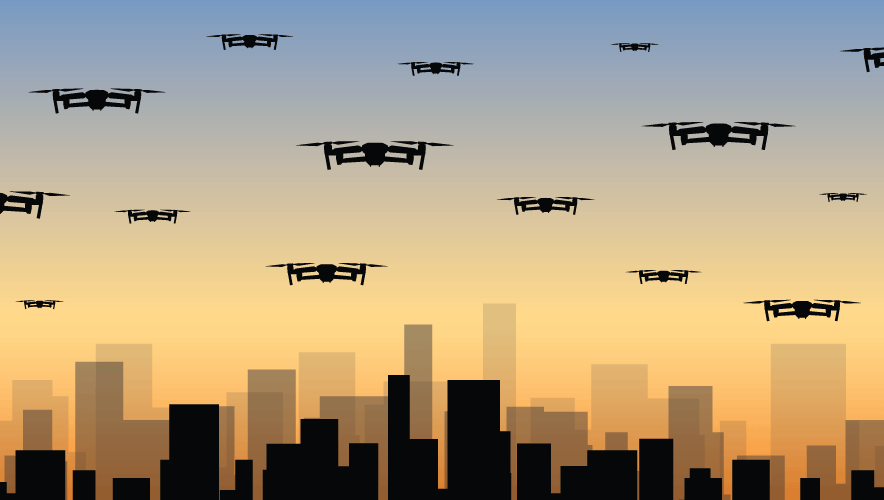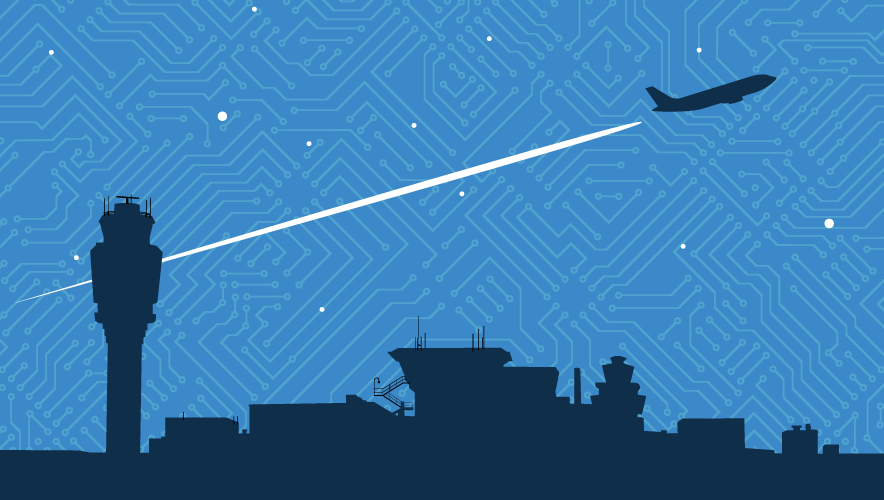Drone Swarms: The Good, The Bad, and The Terrifying Future
Uncrewed vehicles, whether in the form of flying drones or ground-traversing robots, represent both opportunities and challenges for security—be it nation-state security or corporate security. The technological sophistication of the units has increased, costs have decreased, and seemingly the only limitation on how they could be used is imagination.
One way those three elements—technical capabilities, low cost, and creative use—converge is the use of uncrewed vehicle swarms. The U.S. Government Accountability Office’s (GAO's) Science, Technology Assessment, and Analytics September 2023 report shined a spotlight on drone swarm technologies.
“Drone swarm technologies coordinate at least three and up to thousands of drones to perform missions cooperatively with limited need for human attention and control,” according to the report.
And as a video from UK-based Forces News shows, swarm technology is also applicable to non-aerial vehicles as well.
How They Work
Uncrewed vehicle swarms can function in different ways. The GAO report depicts three levels of sophistication. Centralized control, where one or more human operators control the vehicles individually, is the least sophisticated. Decentralized control falls in the middle and is categorized by a human operator sending controls to the vehicles, which also send signals to each other. The most sophisticated is a fully autonomous or decentralized swarm. Autonomous vehicles are programmed with an objective, and they communicate with each other without further human intervention to accomplish their mission.
The most sophisticated, fully autonomous uncrewed vehicle swarm requires artificial intelligence (AI), a technology which is rapidly maturing. Use of AI-directed drone swarms has long been predicted, including in the ASIS Foundation’s 2021 Artificial Intelligence in Security research report; the first reported use was the Israel military’s use in an operation in Gaza in 2021.
“Mortar support companies were re-equipped with swarm drones which reportedly gathered intelligence, located targets, and carried out attacks on Hamas forces,” Forbes reported. “It also provided targeting information for guided mortar weapons and carried out more than 30 ‘successful operations’ against militants attempting to launch rockets at Israel.”
From the Forbes description, it sounds like the operation may have been a middle ground between fully autonomous swarm operations and semi-autonomous, or decentralized. Israel's use of a drone swarm, as described in the article, is different than Russia’s launches of groups of kamikaze drones into Ukraine—often described in media accounts as “swarms”—because those drones are not coordinating with each other.
As one company building systems in the drone space, Shield AI, described, it’s product enables autonomous vehicles to carry out diverse military missions in “data-denied [and] GPS-denied environments.”
Beyond national military capabilities, there are other use case scenarios for drone swarms.
The Good
The GAO report listed several positive opportunities for the use of drone swarms.
- Agriculture: Planting seeds, identifying disease outbreaks by surveilling large areas, and deploying crop treatments.
- Emergency management: Locating missing people or delivering emergency care and supplies during natural disasters. Firefighters could use drone swarms for tracking and controlling the spread of wildfires. Departments could also use drone swarms for collecting information about access points, damages, and more.
- Entertainment: Swapping out fireworks for drone swarms as alternative entertainment displays. This can reduce pollution, fire risks, and disturbances to animals and humans.
Drone swarms are also being studied for use in corporate security settings. An article on University of Houston Aaron Becker described the work he is doing in drone security as “aerial security coverage of a commercial facility and campus. Drones must escort vehicles that enter and leave the campus, but each drone has limited battery life and must recharge when batteries are depleted.”
Meanwhile, Virgina Tech researcher Ryan Williams is studying how to deploy autonomous vehicle swarms to more quickly find people lost in the wilderness. It is not a big stretch to see how such a system could be used to patrol a large area, such as a port or mining operation, searching for unauthorized access and activity.
The Bad
Admittedly, “the bad” and the “the terrifying” are two sides of the same coin. Here, we'll start with the merely bad.
Five years ago, organized criminals used dozens of drones to disrupt an FBI hostage rescue team. The action was certainly centralized control, and, while few details have been reported, it likely involved multiple drone operators. It may be some time before even sophisticated organized criminal enterprises, such as drug cartels, gain autonomous capability, but that time will come.
In addition, the techniques critical infrastructure companies use to remotely surveil installations by drone can be used to probe the installations for weaknesses to exploit. The same can be said for many commercial uses: it is just as easy to deploy poison to crops as fertilizer.
Drones have also become another vector of concern for corporate espionage. All it takes is an imaginative criminal to find ways to use autonomous vehicle swarms to help steal corporate secrets or gain access to corporate networks or facilities.
Finally, regulation and legal frameworks have not kept pace with existing drone use and technology, and is woefully inadequate to deal with emerging uses such as swarms powered by AI.
“The threat of a sophisticated, high-profile [aerial vehicle-borne improvised explosive device] attack is compounded by an inadequate legal and regulatory framework,” Zev Faintuch wrote in a Security Management article in May, part of a package of articles on uncrewed aerial systems. “Only the Departments of Justice and Homeland Security currently have the authority to down drones. The Biden administration introduced a national action plan in 2022 that called for new legislation to update counter-drone practices and for delegating capabilities across federal, state, and local authorities.”
The Terrifying Future
We just touched on imagination—it’s this combined with technological sophistication and decreased costs costs that drive the terrifying scenario. These three determining factors point to autonomous vehicles being both less costly to build and much more capable—capable of moving farther and faster, carrying more, and becoming more maneuverable. Likewise, AI is making leaps forward.
The headline of a commentary article on national security website War on the Rocks gives the true terrifying future message: “Drones of Mass Destruction: Drone Swarms and the Future of Nuclear, Chemical, and Biological Weapons.”
“As the technology underlying drone swarms matures and spreads, the barriers to entry will almost inevitably fall,” the authors surmise. “After all, when reading about drones in 2010, how many readers would have thought that an organization such as Islamic State would have mounted hundreds of drone attacks in a single month or that commercial drones would shut down airports?”
A similarly themed article in the The Atlantic, “The Tiny and Nightmarishly Efficient Future of Drone Warfare,” quoted Samuel Bendett, a warfare expert at the U.S. Center for Naval Analyses, talking about swarms of autonomous drones.
“This is the holy grail. This is what everybody’s working towards,” Bendett said. “By everybody, I mean advanced countries and advanced militaries hoping to utilize swarm technologies. So the list is short, but it’s slowly growing. Of course, it’s the United States, it’s Israel, it’s China, it’s Russia, it’s Turkey, it’s Iran, and perhaps a handful of other states like India and South Korea.”
Bendett named eight countries who have built or are seeking to weaponize autonomous vehicle swarms that promise to redefine the destructive capability of warfare.
Combining nightmares, the War on the Rocks authors propose that these swarms by definition rely on communication between and among the vehicles, making them “particularly vulnerable to electronic warfare attacks” like cyber hijacking.
The GAO report is one of many that have worked to call attention to the issue of drone swarms. Many articles have been written about the need to address the emerging threat of autonomous vehicle swarms, though few offer specifics about how to effectively do so. Mostly, corporate and national security leaders are left with more questions than solutions.
“When you consider that a drone swarm consisting of many thousands of off-the-shelf drones would cost less than, say, one F-35 fighter or a ballistic missile, you have a weapon that would give rogue states or terrorist groups the means to launch devastating attacks or assassinations anywhere in the world,” The Atlantic report said. “Since the Korean War, American forces have controlled the skies wherever they have gone into battle. No other nation had the means to compete with it; the cost, the technology, the experience, and the level of training required are beyond the reach of even the most affluent nation-states. Drone swarms could end that domination. An aircraft carrier? A commercial airliner? The White House? The president? Sitting ducks.”












